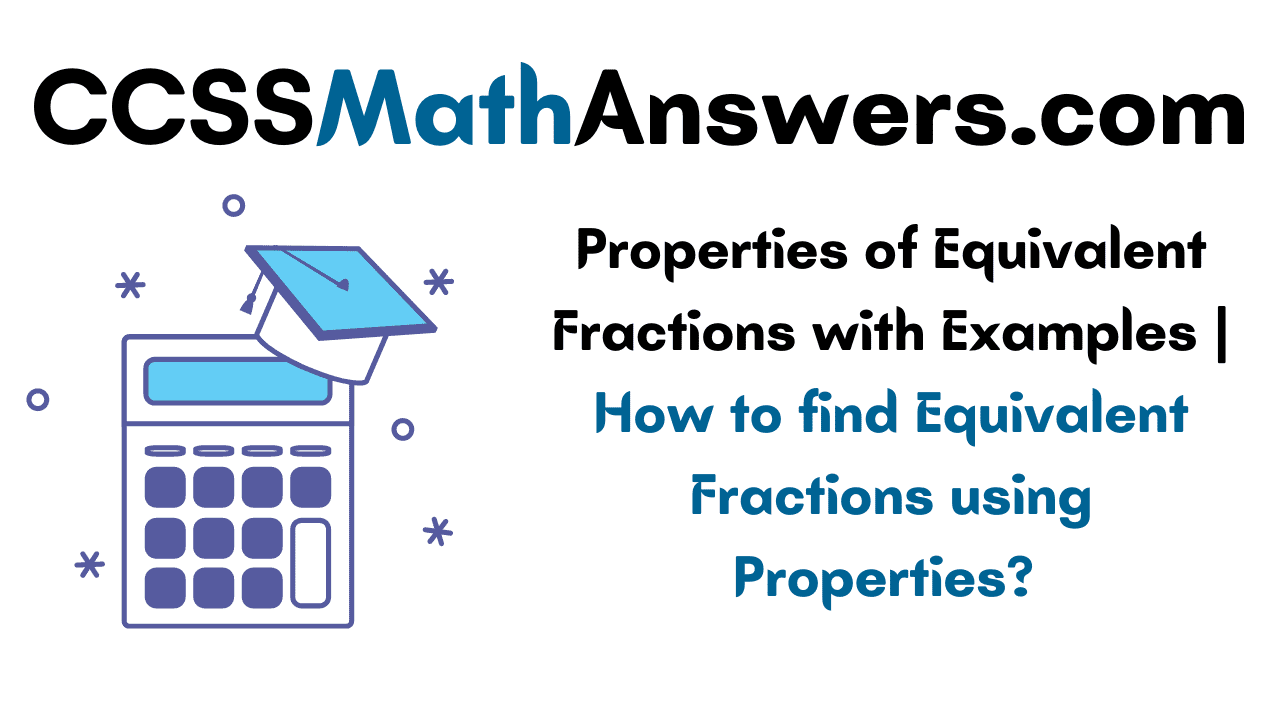Wondering how to solve problems related to Equivalent Fractions? Don’t Fret as we will give you a complete idea of What does an Equivalent Fraction means and how to solve problems on finding & simplifying Equivalent Fractions, etc. You can simplify the Equivalent Fractions Questions easily if you are aware of the Properties of Equivalent Fractions. Apply the Properties while solving problems on Equivalent Fractions and arrive at the solution hassle-free.
Do Read:
What is meant by Equivalent Fractions?
Equivalent Fractions are the Fractions that have different numerators and denominators but represent the same value on a whole when simplified. For Example: \(\frac { 12 }{ 2 } \), \(\frac { 6 }{ 1 } \), \(\frac { 24 }{ 4 } \) are all Equivalent Fractions which on simplifiation results in the same value \(\frac { 6 }{ 1 } \).
Properties of Equivalent Fractions
Equivalent Fractions have certain properties and we have discussed them step by step. They are as follows
- If you multiply the numerator and denominator of the fraction with the same number other than zero, the fraction value remains the same and you can obtain the equivalent fraction.
- If the numerator and denominator of the fraction are divided with the same number except zero there won’t be any change in the fraction value and you can get the equivalent fraction.
- If you have two equivalent fractions, the product of the numerator of the first fraction and the denominator of the second fraction is the same as the product of the denominator of the first fraction and the numerator of the second fraction.
- We can reduce an equivalent fraction to its lowest form by simply dividing both the numerator and denominator by their greatest common factor.
Properties of Equivalent Fractions Examples
Example 1.
Check if the fractions \(\frac { 12 }{ 3 } \) and \(\frac { 15 }{ 5 } \) are equivalent or not?
Solution:
Given Fractions are \(\frac { 12 }{ 3 } \) and \(\frac { 15 }{ 5 } \)
We know according to the properties of equivalent fractions, two fractions are said to be equivalent if the product of the numerator of the first fraction and the denominator of the second fraction is the same as the product of the denominator of the first fraction and the numerator of the second fraction.
Let us verify if they are equal or not.
\(\frac { 12 }{ 3 } \) ⤨ \(\frac { 15 }{ 5 } \)
= 12*5 ≠ 3*15
60 ≠ 45
Thus, the given fractions are not equivalent.
Example 2.
Simplify the Fraction to its lowest form \(\frac { 10 }{ 24 } \)?
Solution:
Given Fraction is \(\frac { 10 }{ 24 } \)
In order to simplify or reduce the fraction to its lowest form, we need to divide both the numerator and denominator of the fraction with their greatest common factor.
GCF(10, 24) = 2
Dividing the fraction with GCF we get the simplified fraction as
\(\frac { 10 }{ 24 } \) = \(\frac { 10÷2 }{ 24÷2 } \)
= \(\frac { 5 }{ 12 } \)
Therefore, \(\frac { 10 }{ 24 } \) reduced to lowest form is \(\frac { 5 }{ 12 } \)
Example 3:
Find the Equivalent Fractions of the Fractions \(\frac { 3 }{ 4 } \)?
Solution:
We Know the Equivalent Fractions of a Fraction can be obtained by simply multiplying or dividing the numerator and denominator of the fraction with a non-zero number.
\(\frac { 3 }{ 4 } \) = \(\frac { 3 }{ 4 } \) * 2 = \(\frac { 6 }{ 8 } \); \(\frac { 3 }{ 4 } \) * 3 = \(\frac { 9 }{ 12 } \); \(\frac { 3 }{ 4 } \)*4 = \(\frac { 12 }{ 16 } \); etc.
Therefore, equivalent fractions of fraction \(\frac { 3 }{ 4 } \) are \(\frac { 6 }{ 8 } \); \(\frac { 9 }{ 12 } \); \(\frac { 12 }{ 16 } \); etc.
Example 4:
Check whether the fractions \(\frac { 12 }{ 16 } \), \(\frac { 9 }{ 12 } \) are Equivalent or Not?
Solution:
Given Fractions are \(\frac { 12 }{ 16 } \), \(\frac { 9 }{ 12 } \)
To verify whether the fractions are equivalent or not we will apply the properties of equivalent fractions i.e. product of the numerator of the first fraction and the denominator of the second fraction is the same as the product of the denominator of the first fraction and the numerator of the second fraction.
= \(\frac { 12 }{ 16 } \) ⤨ \(\frac { 9 }{ 12 } \)
12*12 = 16*9
144 = 144
As the product is the same on cross multiplying we can say both the fractions are Equivalent.
